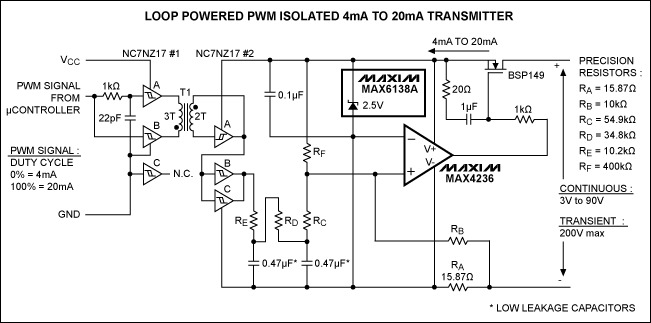This loop-powered, 4–20mA precision transmitter includes a precision PWM signal coupler with galvanic isolation from the PWM signal source. The external PWM-encoded signal is a rectangular waveform generated by a microcontroller or PWM modulator, and is usually produced by a control algorithm run by the microcontroller from a sensor output or other analog-command level.
A similar version of this article appeared in the February 24, 2009 issue of
EE Times magazine.
The accuracy of a 4–20mA transmitter depends on the integrity of its current-loop path, which must be free of shunt paths and ground loops—both within the transmitter and external to it. External to the transmitter are spurious paths in the outside loop wiring and its power supply. Internal to the transmitter, shunt paths and ground loops are usually created at the point where you insert a control signal i一體電感器nto the transmitter circuitry. To eliminate errors introduced by possible spurious current paths, the signal must be DC coupled with full galvanic isolation yet inserted with accuracy.
The circuit of
Figure 1 comprises a loop-powered 4–20mA precision transmitter 插件電感(MAX4236, BSP149, and
MAX6138A) with large-compliance output stage, and a precision PWM signal coupler with galvanic isolation from the PWM signal source.
 Figure 1. This loop-powered 4–20mA transmitter features PWM drive and galvanic isolation from the input signal.
Figure 1. This loop-powered 4–20mA transmitter features PWM drive and galvanic isolation from the input signal.The external PWM-encoded signal is a rectangular waveform generated by a microcontroller or PWM modulator, and is usually produced by a control algorithm run by the microcontroller from a sensor output or other analog-command level. The input-signal duty cycle represents the original signal as a percentage of an arbitrary reference. In this case, the PWM-coupler values are adjusted so a 0% duty cycle corresponds to 4mA from the transmitter, and a 100% duty cycle corresponds to 20mA.
Sections A and B of the NC7NZ17#1 (a TinyLogic UHS triple buffer with Schmitt-trigger inputs) form a bipolar edge detector that applies a short 20ns pulse to the 3-turn primary of transformer T1. The polarity of this pulse depends on the sign of the input edge 電感磁芯being detected.
At the secondary of T1, the pulse sets or resets the flip-flop formed by buffer #2A and the secondary, thereby replicating the input signal at the output of #2A. T1 is a 3-to-2-turn transformer built around a Fair-Rite ferrite core, type 2673000101. Its small size (3.5mm in diameter and 3.25mm in length) yields < 1pF of capacitance at the primary and secondary. The maximum voltage it can withstand depends on the wire insulation used and the way T1 is mounted.
The two remaining buffer sections (B and C) are connected in parallel with their inputs attached to the flip-flop output. Their outputs produce a precision signal whose duty cycle replicates that of the input signal, yet provides precise and stable low/high values—thanks to the CMOS output that tracks the rail voltages exactly, and to the precision reference (MAX6138A) that serves as the transmitter power supply.
The paralleled buffer outputs drive a low-pass filter whose output is the average of the reconstituted PWM input signal, referred to the value of the transmitter supply voltage (the 2.5V precision reference). This average value is a stable and very linear analog of the input signal's duty cycle. Fast propagation in the coupler (< 30ns H

L and L

H), and its small skew (< 2ns) ensure that negligible nonlinearity is introduced by the digital part of the coupler. The recovered average value drives the transmitter output, producing 4mA at 0% duty cycle and 20mA at 100%. For PWM input frequencies in the range 500Hz to 50kHz, the circuit operates with less than 0.1% coupler insertion error.
After power-up, power-loss, or loss of input signal, the Fig
貼片電感器ure 1 circuit's output state can remain undetermined until after the next input transition edge. The circuit of
Figure 2 removes that ambiguity with an "input-transitions loss detector." When triggered by an interval of approximately 3ms with no transitions, it connects the transmitter directly to the output of an optocoupler. The optocoupler senses the state of the input line at which it is resting, and imposes that state on the output current. That is, H state = 100% duty cycle
大功率電感廠家 |
大電流電感工廠
功率電感線圈 功率電感線圈是由導(dǎo)線一圈*一圈地繞在絕緣管上,導(dǎo)線彼此互相絕緣,而絕緣管可以是空心的,也可以包含鐵芯或磁粉芯,簡(jiǎn)稱(chēng)功率電感。用L表示,單位有亨利(H)、毫亨利 (mH)、微亨利(uH),1H=1
電流互感器磁芯復(fù)位問(wèn)題求教【有圖】 上圖是趙修科老師192頁(yè)中,脈沖直流互感器的一段截圖
右側(cè)原理圖表示的一個(gè)電流互感器,有句話不明白
初級(jí)電流斷開(kāi)后,次級(jí)感應(yīng)電勢(shì)下正上負(fù),二極管反向截止,怎么能磁復(fù)位??
七段LED數(shù)碼管結(jié)構(gòu)(a) 管腳圖 (b) 共陰極 (c) 共陽(yáng)級(jí)七段LED數(shù)碼管的驅(qū)動(dòng)電路(a) BCD 七段譯碼法 (b) 軟件譯碼法多位七段LED數(shù)碼顯示器結(jié)構(gòu)利用人的視覺(jué)延遲的特點(diǎn),采用掃描的方式驅(qū)動(dòng)多位七段LE


 L and L
L and L  H), and its small skew (< 2ns) ensure that negligible nonlinearity is introduced by the digital part of the coupler. The recovered average value drives the transmitter output, producing 4mA at 0% duty cycle and 20mA at 100%. For PWM input frequencies in the range 500Hz to 50kHz, the circuit operates with less than 0.1% coupler insertion error.
H), and its small skew (< 2ns) ensure that negligible nonlinearity is introduced by the digital part of the coupler. The recovered average value drives the transmitter output, producing 4mA at 0% duty cycle and 20mA at 100%. For PWM input frequencies in the range 500Hz to 50kHz, the circuit operates with less than 0.1% coupler insertion error.